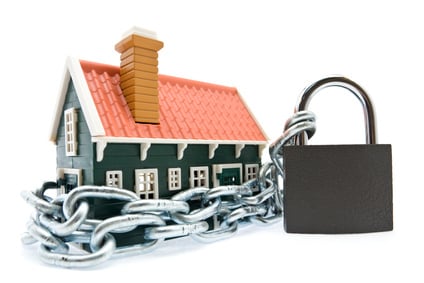Many buyers are worried that if they buy a home today, that home might go down in value tomorrow. But there is a way for any home buyer to protect themselves from the dangers of eroding home values.

Protect your home investment © Arpad Nagy-Bagoly - Fotolia.com
As an investor, I need to know how much to pay for a home in any neighborhood in any market. To do this, I devised a simple system for coming up with a good offer price. I use my system primarily to determine offer prices on properties to be used for investment, but it will work for an owner-occupant buyer as well.
It's sort of a hybrid between residential and commercial ideas about appraisal. Over the years I've had to deal with a lot of different types and sizes of residential properties, built over long periods of time. The challenge was to come up with a way to quickly determine a reasonable market value and offer price, when the homes were in different parts of town, or were built in the same neighborhood, but built 100 years apart. When shopping for homes in the city, you'll find that they come in a wide variety of shapes, sizes and materials.
This system addresses the idea that things can be very different from one neighborhood to the next. It's a technique I call "Dollars Per Square Foot Averaging". It's a simple idea that has worked very well for me, and is pretty easy to understand.
The idea is to compare the recent selling prices of homes in the immediate neighborhood, with the home you are considering buying. But instead of making lots of arbitrary adjustments to add or subtract for various items that are in one house but not another, you simply divide the sales price by the total heated and cooled square footage of the property.
For example: Property A sells for $100,000 and has 1000 square feet. It's "dollars per square foot average" would be $100 per square foot.
Property B sold for $125,000 and it has 1347 square feet. It's average per square foot is $92.80.
Property C sold for $128,000 and it has 1421 square feet. It's average per square foot is $90.08
You can already see that Property C appears to be the best overall value. It has the highest apparent selling price, but on a per square foot basis, it's the cheapest of the three. But wait, there's more...
Next, take those averages for all three properties, add them together, and divide by 3, to get the "dollars per square foot average". In this case, it's $282.88 / 3 = $94.29 average dollars per square foot.
Once you have this average, simply take the square footage of the property you are interested in buying, and multiply it by the "average dollars per square foot". Let's say that the house we are interested in buying has 1380 square feet. That would be $94.29 X 1380 = $130,124.
In this example our subject property is likely worth somewhere in the range of $130,124. In my experience, both in the years before the housing crisis, and in the years since, I've found this system to be highly reliable if you are using very recent sales data, from properties in the same neighborhood.
From there you can check to see if home prices have been going down in this neighborhood, by looking at selling prices recorded during the same time period a year earlier. Let's say that you did this and found that prices had gone down some 7% from 2010 to 2011. So you can reduce your offer price by 7% or more, to allow you to compensate for any concerns about prices falling during your first year of ownership. If you want to be more conservative, you can reduce your offer price even further.
But the point is, this example gives you a structured way to come up with an offer price that you can present to the seller with specific reasons why you believe it is a very reasonable offer for the seller to consider. Half the battle in getting a seller to discount their selling price is to convince them that your offer is reasonable because it is based on current market conditions. This technique gives you a way of doing that.
And if you find that the property you'd like to buy is under-priced on a per-square-foot basis, when compared to those other recent sales, you'll know right off the bat that this house might be a really good deal.
Knowing how to use "dollars per square foot averaging" can give you a higher confidence level when buying any home in any neighborhood, especially when prices have been going down instead of up. When homes appreciate quickly it's easy to make up for buying mistakes, but when home prices are falling, or flat, it's important to know that your offer price will not be too high. Many buyers are flying blind when making offers for a home. This is a simple way to avoid making big mistakes.
-------------------------------------------------------------------------------------------------
Donna Robinson is a regular contributor to Realty Biz News, and has spent many years in the real estate industry. She has worked as a consultant and coach to major real estate investment companies, as well as helping buyers and sellers find creative solutions to their real estate problems. Contact Donna at [email protected] and request her free report for home buyers or real estate investors.